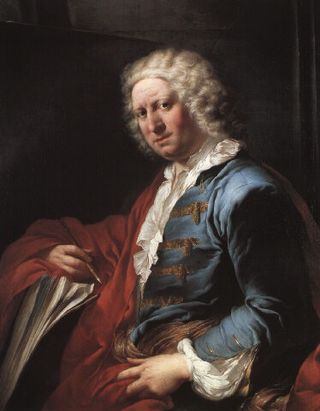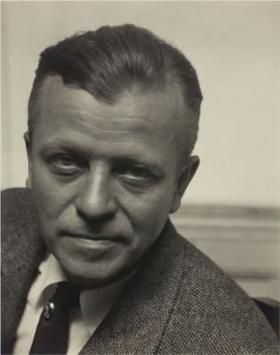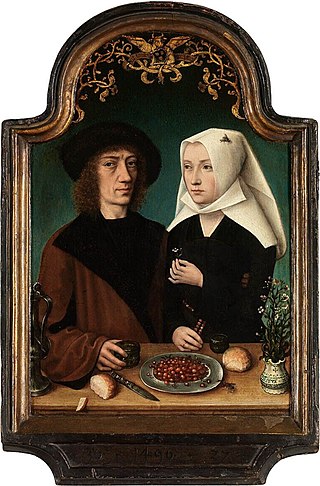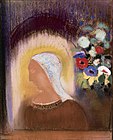
Antonio Allegri da Correggio, usually known as just Correggio was an Italian Renaissance painter who was the foremost painter of the Parma school of the High Italian Renaissance, who was responsible for some of the most vigorous and sensuous works of the sixteenth century. In his use of dynamic composition, illusionistic perspective and dramatic foreshortening, Correggio prefigured the Baroque art of the seventeenth century and the Rococo art of the eighteenth century. He is considered a master of chiaroscuro.

George Stubbs was an English painter, best known for his paintings of horses. Self-trained, Stubbs learnt his skills independently from other great artists of the 18th century such as Reynolds and Gainsborough. Stubbs' output includes history paintings, but his greatest skill was in painting animals, perhaps influenced by his love and study of anatomy. His series of paintings on the theme of a lion attacking a horse are early and significant examples of the Romantic movement that emerged in the late 18th century. He enjoyed royal patronage. His painting Whistlejacket hangs in the National Gallery, London.

Antonello da Messina, properly Antonello di Giovanni di Antonio, but also called Antonello degli Antoni and Anglicized as Anthony of Messina, was an Italian painter from Messina, active during the Italian Early Renaissance.

Giovanni Paolo, also known as Gian Paolo Panini or Pannini, was an Italian painter and architect who worked in Rome and is primarily known as one of the vedutisti. As a painter, Panini is best known for his vistas of Rome, in which he took a particular interest in the city's antiquities. Among his most famous works are his view of the interior of the Pantheon, and his vedute—paintings of picture galleries containing views of Rome. Most of his works, especially those of ruins, have a fanciful and unreal embellishment characteristic of capriccio themes. In this they resemble the capricci of Marco Ricci. Panini also painted portraits, including one of Pope Benedict XIV.

Arthur Garfield Dove was an American artist. An early American modernist, he is often considered the first American abstract painter. Dove used a wide range of media, sometimes in unconventional combinations, to produce his abstractions and his abstract landscapes. Me and the Moon from 1937 is a good example of an Arthur Dove abstract landscape and has been referred to as one of the culminating works of his career. Dove made a series of experimental collages in the 1920s. He also experimented with techniques, combining paints like hand mixed oil or tempera over a wax emulsion as exemplified in Dove's 1938 painting Tanks, in the collection of the Boston Museum of Fine Arts.
Kathy Vargas is an American artist who creates photographs from multiple exposures that she hand colors. She often devotes several works to a particular theme, creating series.
César Augusto Martínez is an artist, prominent in the field of Chicano art. While studying at what was then called Texas A&I College, he became involved in the Chicano movement for civil rights. He subsequently befriended several of its leaders.

Marion Koogler McNay, was an American painter, art collector, and art teacher who inherited a substantial oil fortune upon the death of her parents. She later willed her fortune to be used to establish San Antonio's first museum of modern art, which today bears her name. Inspired by Modern, Impressionistic, and American art, she used her wealthy background to cultivate her eclectic art collection. McNay was able to design her San Antonio home after moving there in 1926. As soon as McNay moved to San Antonio, she began buying and commissioning art pieces. The Spanish styled house was able to showcase a diverse amount of paintings, including both American and European styled art. McNay favored art made in the Southwestern American style. The fortune she inherited funded her art collection that included over seven hundred works by 1950, the year of her passing. McNay's home, art collection, property, and an endowment were left to the city of San Antonio after her death. McNay's goal was to provide the people of San Antonio "a place of beauty with the comforts and warmth of a home."

The Master of Frankfurt was a Flemish Renaissance painter active in Antwerp between about 1480 and 1520. Although he probably never visited Frankfurt am Main, his name derives from two paintings commissioned from patrons in that city, the Holy Kinship in the Frankfurt Historical Museum and a Crucifixion in the Städel museum.

Ben L. Culwell was an American painter and early participant in the abstract expressionist movement. He is most widely known for his participation in the Museum of Modern Art's 1946 Fourteen Americans exhibition. His work is included in the permanent collection of Houston's Menil Collection, the Dallas Museum of Art, the Houston Museum of Fine Arts, as well as the Museum of Modern Art in New York City. In 1977, Culwell's work was featured in a retrospective at the McNay Art Museum. Ten years later in 1987, Culwell's early paintings were featured in Adrenalin Hour, an exhibition given at the opening of the Menil Collection, to critical acclaim. In 2007, his work was included in an exhibition at Baylor University, Texas Modern: The Rediscovery of Early Texas Abstraction 1935–1965.
Michael Frary was an American Modernist artist from Santa Monica, California, who was known for his interest in structural forms and architectural compositions, as well as for his Surrealist impulses. A versatile artist, Frary experimented with a range of mediums and constantly refined his approach to his subjects.

Marcia Gygli King was an American artist.
William J. Chiego is an American museum curator, who has been director of the McNay Art Museum in San Antonio since 1991.

Woman with a Fan is a painting by the French artist Jean Metzinger. The work was exhibited in 1914 at Moderni Umeni, S.V.U. Mánes, Prague. A 1914 photograph taken at the exhibition in Prague was published in the magazine Zlatá Praha showing Woman with a Fan hanging next to another work by Metzinger known as En Canot , 1913. Donated by Mr and Mrs Sigmund Kunstadter in 1959, Woman with a Fan forms part of the permanent collection in Gallery 391B at the Art Institute of Chicago, US.
Vincent Valdez is an American artist born in San Antonio, Texas, who focuses on painting, drawing, and printmaking. His artwork often emphasizes themes of social justice, memory, and ignored or under-examined historical narratives. Valdez completed his B.F.A. at the Rhode Island School of Design in 2000. He lives and works in Houston, Texas, and is represented by the David Shelton Gallery (Houston) and Matthew Brown Gallery. Valdez's work has been exhibited at Museum of Fine Arts, Houston, Ford Foundation, Los Angeles County Museum of Art, National Portrait Gallery, Blanton Museum of Art, Parsons School of Design, and the Fundacion Osde Buenos Aires.
Libby Black is an American contemporary artist working primarily in drawing, painting, and sculpture. Black lives and works in Berkeley California.
















